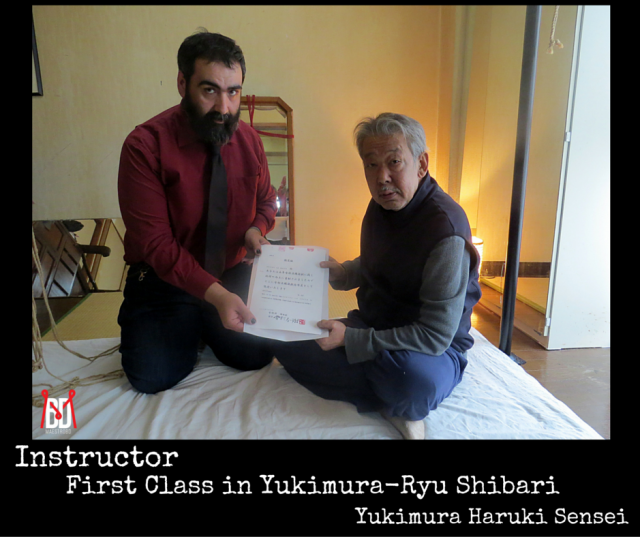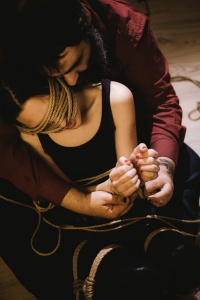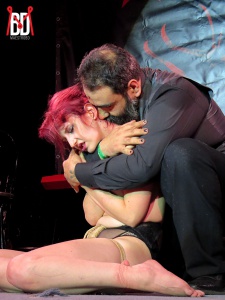 1. How did you get started in kinbaku? When did you begin? What were your early influences?
1. How did you get started in kinbaku? When did you begin? What were your early influences?
I started doing western bondage in ‘90, alone, I was just playing with ropes and looking onto magazine, my first Japanese photos about Kinbaku were some pictures of Go Arisue, I started to love the designand the emotion that came from his works.
When I was a young boy I was into martial arts and Japanese Culture, because of that I was driven to search for any reference on Shibari, first findings was merely scraps but still were a starting point. I was learning by copying what I was looking to and trying to fill the gaps in the passages anywhere I could not find images. Year by year I
got my hands on english books like the one wrote by Midori “The seductive art of Japanese Bondage” and some videos. And even with those to help only practice was my real teacher, motivated by my desire to capture those type of expressions like the ones in the photos of Nobuyoshi Araki and other unknown Kinbakushi found on the
magazines in adult stores.
2. What do you enjoy about rope? How would you describe your passion?
For me Shibari equals to communication, to transmit and receive emotions trough the jute. Ropes are a mean of communication between me and the “bottom”, I put in them want I want to transmit, and I get feedback, I amplify it and send it back, in a continuous process of exchange that allow me to build an enclosed private space where only the “bottom” and I are present.
I love the trust that I feel from the “bottom” while he or she abandon his/herself to the ropes, maybe after a little struggle. I create a safe space where the “bottom” is able to experience his/her fantasies and walk trough his/her personal and intimate trails, the desires and passions, those moments where I get my hold on a moan as well as an unexpected pleasure.
In my own opinion Shibari is the creation of this intimate link with the “bottom”, whether or not the “bottom” is my partner or a perfect unknown person which is approaching the practice out of pure curiosity I feel responsible for his/her security and I see the emotions he/she feels as a gift, I feel my goal replying to this gift with the full dedication and passion.
Doing Shibari means to build a pure feeling between two person, bound not only the body but the respective essences as well from the first breath to the last embrace. It is a discipline that touch all senses, from the personal and deep ones like touch, scent and flavour to the aesthetic one like sight and hearing. I think I create something that touch all these aspects, and at the same time it is meant to be pleasured not only by who
experience it inside the safe space, the Bakushi and the “bottom”, but even by a supposed or real spectator.
Kinbaku is similar to dancing: you do it for yourself, but as if the whole world is looking at you.
3. What was it like to work with Yukimura sensei? How did he influence your rope?
I felt Master Yukimura was the right choice after listening to the experience of a french friend which studied under him, Philipp Ann, he told me the Master was living ropes for the sake of his bottom’s emotions. So I went straight to find him. It was not easy to have the first lesson: I went trough two different friends of mine that introduced me to Nuit De Tokyo, which I recognize as a mentor and a friend; he organized my first lesson and opened me to the scene in Tokyo with unique grace and caring.
Knowing the Master was a true revelation, it was like his words opened closed drawers within me, he freed my ropes and my emotions. He helped me understand it was not strange to feel such strong emotions trough bindings and that technique comes after the passion you put into it.
At the time it was settled a point between Pre-Yukimura experience and After-Yukimura: when I got back to Italy in 2014 the first thing everyone noticed was that I was changed, my ropes changed, my way of
binding changed, everything changed. It was all more intense, stronger, I was more aware of my personal
emotions, and more sensual in fact.
Working with him was understanding Kinbaku in its most pure form, not the outside, but its true essence. The Master cotninued to show me how to enter in connection with the bottom or the model, how to
communicate with infinite courtesy and care. Every word was of value, even during pauses, at the time he was asking about italian situation, as well as my personal life. It was not hasty courtesy, but in fact the desire to undestrand me better in order to teaching me better.
He showed me a way, a journey to follow in searching of emotions. And that is the way I follow with my ropes.
4. How would you describe your connection with your partner when you tie?
It is an open channel trough which emotions flow, everyone of them. Both the light and frail ones, as well as the stronger and heady ones. Pain, pleasure, shame, I feel all of them with my hands, the ropes, and the other senses. At a precise moment I can feel all of those emotion almost directly, reverberating inside as waves. Scents, sounds, the sensation of flesh over flesh, the colours, everything become a unique music that dictates the movements of hands and ropes.
Even taking a step away, in order to look upon what has been created does not break the connection, on the contrary it allows to get fully the figure of the bottom as a piece of art. It is like as creating a unique being made of two bodies by the means of the ropes, the ones made of jute which binds the body of the bottom and the ideal ones around the binder.
5. Who are some of the bakushi you admire? What do you like about them?
As the most import of all I would say Sensei Yukimura, it is granted to say his presence is palpable inside me and inside my ropes, and I already explained what I admire of him and what I will always admire.
In the 2011 I met for the first time Otonawa, on stage in London, and I fall in love with his stage presence. The way he managed the rhythm on the scene, the passion, the movements, the right timing with the music, Otonawa made me understand Kinbaku had to be like a dance in order to become art, a theatrical element of expression. I admire his ability to express emotions.
Always at that time in London I saw Shigonawa Bingo-san for the very first time, and I met him in Tokyo in 2015. I admire his technical proficiency, his polished ropes and his simple way of teaching.
Yoi Yoshida is an example of ancient style, I am charmed every time I see her works: never a wasted movement, not one time a move out of place, always an infinite attention for the model, almost maternal in her kindness, but like a rigid stepmother in her cruelty when she comes to switching to semenawa without losing her composure. It is a style I deeply admire.
On the other hand, speaking about european bakushi, my preferred one is Bob Ropemarks, his ropes are fast, his style peculiar, it is a pleasure to look and admire him, I have been following him for years and I always looked up to his ability to achieve complex bindings with speed and precision, without losing sight of style.
Another one I admire is Goerge Barkas: with him I valued the ability to teach and transmit the passion, but above all the humaneness, the joy in sharing ropes and play toghether.
Last but not least, I have undivided admiration for Osada Steve, of him I admire the ability to take a complex technique like the Shibari and make it accessible for westerners and to enter a world as complex ad the Japanese one.
On top of that I admire his kindness and the way he makes you feel welcome even while remaining a firm point of reference.
It is needless to say there are more and more people that I admire and look up to, it is a long list of names like Kinoko Hajime, Sin Desu, Ero Ouji, Ren Yagami, Kazami Ranki and so many more I could write a dedicated article only for that. In my own opinion what really counts is the passion they put in it and the proficiency.
6. What do you feel makes Yukimura’s style different or unique?
I would say the focus onto the emotions, put ahead even of the technique. Only security is above everything without question, without that Yukimura’s Style would be only gravitate around pleasure and construction. Pleasure is not only sexual, pain not for the sake of it, everything is an instrument to reach the deepest and absolute pleasure.
His Style put good care into feeling the reactions of the bottom to the stimuli far beyond any other style, more listening and connection and the bindings are a mean to work the bottom emotions. In this Style i noticed a unique focus onto the aesthetics, not the one of the ropes but the one of the body, of its position, the
movement, something I have never seen in other styles.
Another detail that I like of the Sensei himself is respiration, the focus on the rhythm of breathing, both his and of the bottom. He has never taught me anything about it, but listening and looking at him I noticed how he followed the rhythm of his own breathing and aligned it with the breathing of his bottom, sometimes even controlling it trough the bindings and the position.
Yukimura Style made me feel the weight of time, it is a style with something ancient, deep, even the way of teaching, always one to one, a master and a disciple, a style that is impossible to teach to more people at once, as if it was to be taught that way one to one.
7. How is being in Tokyo different from studying in the west? Is there something about being there that alters the learning experience?
It is totally different: here in Europe we have a didactic approach bound to theoretical teaching method, while in Japan I understood the practical method and the need for the repetition of the move. It is something similar to the martial art experience I had in the past, even if it was a little experience, under a Japanese Kendo
master, but unlike Europe it is the common method in Japan.
Everything is taught through practice, continuous and methodic practice, on the other hand theory is important but a secondary aspect.
In Tokyo is like you can breath Kinbaku, even in the moves themselves, contextualizing the passion for the ropes with their origins along with all the things you saw only in some videos, books or comics. Everything feel much more real. Watching a Japanese kinbakushi is watching someone who lives fully and deeply his culture. I was able to better understand concepts that I was used to apply but of which I was not able to grasp the true essence.
Plus that, to be able to practice on japanese bottom made me aware of the vastly of different reactions that ropes provoke: there is a great difference in how a Japanese girl enjoys the ropes instead of a
western one. Culture creates a different reaction to shame and exposure, pivotal concepts of Kinbaku.
8. Did Yukimura sensei pass on anything you can share with us about his feelings and philosophy of shibari and kinbaku?
During last lessons the Sensei asked me about if I wanted to teach Yukimura Style. When he realized it was one of my desires he dedicated an entire lesson on explaining to me the basics of his style, sharing with me its use and objective: to built pleasure, the search for the emotions within the person who place his or her trust in your hands, emotions that are to be looked for and brought to light.
A single statement struck me and I try to share with everyone: Kinbaku allow the woman to live her fantasies, we have to create the space where she can live them without any intermission. Ropes build this internal world from where the bottom pleasure come.
This is the foundamental lesson for me.
9. What do you plan to do now with what you have learned?
Teach it. Among his last lesson to me Sensei told me:”Teach, it is the best way to learn.” And this is what I want, learn Yukimura Style fully, all life long, test it, live it, make it my own until the last day. In the end teach it in order to assure its continuity after me. Transmit passion that was transmitted to me and receive the smile of those ones who decide to be binded by me and their emotions. I too want to try filming my ways in order to transmit my passion and make others feel the same way, I want to show what biding means in Yukimura Style.
10. Did anything you learned alter your perspective or change the way you think about rope?
Absolutely, I went to Japan with a style more technical, antiseptic. I returned with a more intimate and stronger style. Six years ago I already once changed style, my start was an even more technical, all based around knots and symmetry. From 2011 I started a journey of change when I met Kinoko Hajime and Shinogawa Bingo in London, but the true change happened when I saw Otonawa on stage, of which I admired the ability of expression and narration with the ropes. From that one time my approach to the ropes changed and has been changing.
In the last years Kinbaku is my passion and my world, so much to be my only profession. Teaching, doing professional consult, shows and photo albums.
The rope became a bedroom passion and a vital part of my life, both private with my partners and public on the tatami of the Dojo where I teach as well as the stage where I perform my shows.
11. Do you have any plans for teaching or travel?
It has been a little spawn of time that I opened a second school in North Italy, in Pavia, keeping in business the one in Rome, so I divide myself between the two of them with lesson among the month and more courses around Italy.
I like to organize style courses MaestroBD, while I dedicate individual lessons at Yukimura Ryu for those who are really interested in this style.
Aside from the collaborations with La Regina Nera(PlayParty) and Decadence (FetishParty) I also perform a lot of times outside Italy.
About that, I feel really proud of coming back to Tokyo in November in order to participate on the stage at O-nawa Asobi in Roppongi. To be chosen to perform in Japan is a great honor for me. In Tokyo I will continue my learning of Yukimura Ryu Style, I hope to experience other styles as well because you never finish to learn.
12. What advice would you give to someone just beginning?
Be patient. To learn ropes in the technical way little notion are needed, above all safety, and basic knots, all can be learned in few hours. On the other hand to learn Kinbaku a lifetime is not enough. You never finish learning. So do not rush and practice, learn, practice and learn again and again, and then practice again.
The are courses, masters, books, tutorials and endless ways to learn the basics. Obviously I advice to search for someone to learn from, but that is because I did not have a master when I started. It does not matter how you start, the spirit and the willingness are what really count: ropes are easy to handle and first knots are enough to enjoy, but make them part of what we are and really build emotions it is never-ending and unique journey.
Sensei Yukimura, in his last lesson to me, told me:”Gambatte.” which means “Do your best.” and that is what I want to say to everyone that are starting to bind: Gambatte!



















